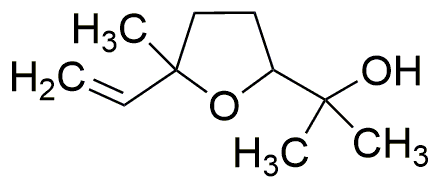Linalool oxide (mixture of isomers) is widely utilized in research focused on:
- Fragrance Industry: This compound is a key ingredient in perfumes and cosmetics, providing a floral and herbal scent that enhances product appeal.
- Flavoring Agent: It is used in food products to impart a pleasant aroma and flavor, particularly in baked goods and beverages, making them more enjoyable for consumers.
- Pharmaceuticals: Linalool oxide has potential applications in drug formulation, where its properties may enhance the effectiveness of certain medications or serve as a natural preservative.
- Insect Repellents: It shows effectiveness in repelling pests, making it a valuable component in eco-friendly insect repellent products for both residential and agricultural use.
- Aromatherapy: This compound is used in essential oils and diffusers, promoting relaxation and well-being, which is increasingly popular in wellness and holistic health markets.
General Information
Properties
Safety and Regulations
Applications
Linalool oxide (mixture of isomers) is widely utilized in research focused on:
- Fragrance Industry: This compound is a key ingredient in perfumes and cosmetics, providing a floral and herbal scent that enhances product appeal.
- Flavoring Agent: It is used in food products to impart a pleasant aroma and flavor, particularly in baked goods and beverages, making them more enjoyable for consumers.
- Pharmaceuticals: Linalool oxide has potential applications in drug formulation, where its properties may enhance the effectiveness of certain medications or serve as a natural preservative.
- Insect Repellents: It shows effectiveness in repelling pests, making it a valuable component in eco-friendly insect repellent products for both residential and agricultural use.
- Aromatherapy: This compound is used in essential oils and diffusers, promoting relaxation and well-being, which is increasingly popular in wellness and holistic health markets.
Documents
Safety Data Sheets (SDS)
The SDS provides comprehensive safety information on handling, storage, and disposal of the product.
Product Specification (PS)
The PS provides a comprehensive breakdown of the product’s properties, including chemical composition, physical state, purity, and storage requirements. It also details acceptable quality ranges and the product's intended applications.
Certificates of Analysis (COA)
Search for Certificates of Analysis (COA) by entering the products Lot Number. Lot and Batch Numbers can be found on a product’s label following the words ‘Lot’ or ‘Batch’.
*Catalog Number
*Lot Number
Certificates Of Origin (COO)
This COO confirms the country where the product was manufactured, and also details the materials and components used in it and whether it is derived from natural, synthetic, or other specific sources. This certificate may be required for customs, trade, and regulatory compliance.
*Catalog Number
*Lot Number
Safety Data Sheets (SDS)
The SDS provides comprehensive safety information on handling, storage, and disposal of the product.
DownloadProduct Specification (PS)
The PS provides a comprehensive breakdown of the product’s properties, including chemical composition, physical state, purity, and storage requirements. It also details acceptable quality ranges and the product's intended applications.
DownloadCertificates of Analysis (COA)
Search for Certificates of Analysis (COA) by entering the products Lot Number. Lot and Batch Numbers can be found on a product’s label following the words ‘Lot’ or ‘Batch’.
*Catalog Number
*Lot Number
Certificates Of Origin (COO)
This COO confirms the country where the product was manufactured, and also details the materials and components used in it and whether it is derived from natural, synthetic, or other specific sources. This certificate may be required for customs, trade, and regulatory compliance.

